Chapter 1: Contents
Notes:
The chapter names are links so you can click them to go to that section.
(See the end of the chapter for more notes.)
Chapter Text
Contents:
-
Parts of a guitar
-
Gear needed to play
- Models
- Pickups
- Signatures
-
Common Techniques
- Power chords
- Open chords
- Barre chords
- Natural Harmonics
- Pinch Harmonics
- Artificial Harmonics
- Tapped / Touched Harmonics
- Left hand, right hand, thumb muting
- Palm muting
- Other muting techniques
- Down picking
- Alternate picking
- Economy picking
- Sweep picking
- Tremolo picking
The headstock
The neck
The body
Acoustic
Electric
Picks
Capos
Straps
Bends
Chords
Hammer ons
Harmonics
Muting
Picking
Pull offs
Slides
Vibrato
Whammy Bars
Notes:
Forget writing everything, formatting this takes a long time
Chapter Text
As you’re reading this, you’ll probably realise, if you’re not already aware, that the guitar world is full of weird names.
Patrick, Joe, and Pete will know all of the following terminology as it's one of the first things you pick up as a guitarist. Andy most likely knows the intuitive and more commonly used names for the parts of a guitar but may not know the less commonly used words like nut or saddle since he has no reason to know as a drummer that does not play guitar. That's just an educated guess though — it's possible he does know everything.
Most diagrams do a fairly good job of illustrating the different names but I will go into a little more detail for those who want it.
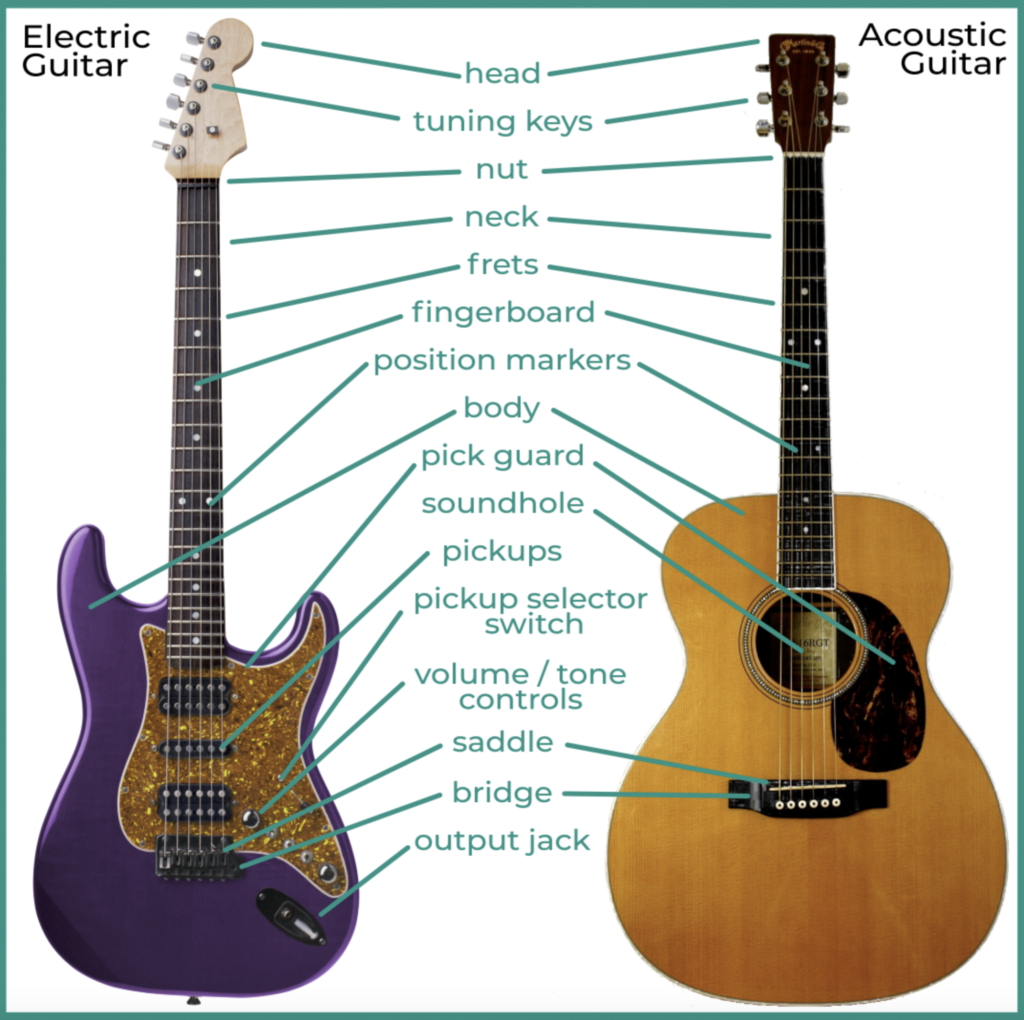
The headstock
Starting at the top of the guitar, the headstock houses the tuning pegs and usually has the brand logo of the guitar painted on. Some guitar brands place serial numbers on the back to help identify them as genuine as well as the date they were made. Signature guitars may also feature the musician’s signature on the back or front.
Tuning pegs have various names including machine heads, tuners, tuning keys, etc., though tuning pegs and tuners are the most commonly used. The ends of the strings are threaded into them and they hold the strings in place. Standard pegs do this through tension and friction. They are tightened to make a string sound sharper and loosened to make a string flatter.
There are locking tuners for electric guitars, which clamp down onto the strings. It can improve the tuning stability of the strings, meaning they will be less likely to go out of tune when played or not played. They are also popular for making it easier to install a fresh set of strings. Locking tuners come with the downside of possibly needing to drill further holes in the headstock, adding more weight to the headstock of a guitar, or creating a ‘bulky’ look, depending on the pegs used.
Since Fall Out Boy has a mix of songs in standard tuning and drop D, they have talked about having Hipshot ‘Xtenders’ installed on the low E string. When the lever is pressed, it changes the note from E to D. It’s not something many people bother installing but it is much more efficient as they don’t need to retune the guitar or swap it out for another one between songs. All of EOWYG and TTTYG, minus the song ‘The Patron Saint of Liars and Fakes’, are in E standard so they wouldn’t have needed them then. I believe it was something they first began using during the Infinity on High era, possibly Folie.
The neck
The headstock and neck are separated by the nut which holds the strings in place over the fretboard. Similar to locking tuners, locking nuts also exist, though I have not seen them used by FOB and they are not common outside of Floyd Rose / floating tremolo guitars.
Metal strips create frets and the frets have inlays to help the guitarist know the fret number. Inlays, or position markers, are usually placed on the 3rd, 5th, 7th, 9th, 12th, 15th, 17th, 19th, and 21st fret. To mark an octave, the 12th fret usually has two inlays or one larger one to mark it as separate from the others. Down the side of the neck that faces the guitarist when playing, there are markings at the same frets since the player can't see much of the neck when playing standing up. Many classical guitars only have position markers on the side of the neck and no inlays.
While position markers are usually small circles or dots, they can be anything. In the early days, Patrick played a Gibson SG with crescent moon inlays.


On Pete’s signature Squier above, there is a bartskull on the 12th fret. On his other signature Sterling bass, the 12th fret is a duck. Stickers can also be placed over them. I for one would love to see Pete play with bat fret markings.
Inside the neck is the truss rod, a metal rod that helps keep the neck in shape and therefore the intonation of the fretboard. Classical guitars don't have one as nylon strings create much less tension on the neck. It's difficult to break a truss rod but you're in trouble if you do, creating the many myths that surround neck warping. Where you can adjust the truss rod from depends on the model of guitar.


The body
The body of the guitar is the bulk of the weight. In electric guitars, it is attached with screws. Inside, it houses the electronics of the instrument and the bodies come in various shapes.
Acoustic bodies are created using thin pieces of wood glued together to create the hollow body. There is a sound hole under the strings which allows sound to reverberate inside, making the instrument louder. The inlaid decoration around the sound hole is called a rosette. Semi-hollow guitars have f-holes — sound holes shaped like the letter f— for a similar reason.
Under the strings on an electric guitar, are the pickups which ‘pick up’ the sound created by the strings like microphones. Most electric guitars have two pickups, called the neck pickup and the bridge pickup, though there are guitars with one or three. The neck pickup is the one closest to the neck and the bridge pickup is closest to the bridge of the guitar. A pickup in between a neck and bridge pickup is helpfully called the ‘middle pickup’.
Which pickup is on and sending an output through the input jack is selected using the selector switch, which can look different depending on the guitar model. A guitar with two pickups will usually have a three way switch and a guitar with three will usually have a five way switch. A pickup that is off will not pick up any sound.
A cable is connected to the jack, located either on the front face of the body or on the side. Semi-acoustic and semi-hollow guitars will have a jack also.
Usually made of acrylic or a similar material, the pickguard on an electric is intended to prevent scratches to the guitar body. For Les Pauls and similar guitars, since they have a rounded body, the pickguard happens to provide a nice, flat place for the guitarist to place their hand on as needed. In some guitar models, they can be removed to allow for access to wiring.

Above is Patrick’s gorgeous Guild s-60D guitar that has a clear pickguard. You can see where the pickup wiring goes if you look closely. (I have to say, it’s a very sexy guitar…)
Also on the guitar body are several knobs, the number of which can vary and usually control volume and tone. Patrick’s guitar above has three. It has a volume control for each pick-up and one knob for tone control.
So what is the difference between a volume knob and pickup selector? The pickup selector turns the pickups ‘on’ or ‘off’ — only two states. The volume knob controls the volume of the pickup which is a value anywhere between 0 and 10.
Let’s use Patrick’s sexy s-60D as an example. If he sets the selector to the middle position, both pickups will be on and can be heard. However, if he turns the volume knob for the bridge pickup down to 0, we will only hear the output from the neck pickup, even though both are on. If he then switches the selector to the bridge pickup, since its volume is 0, the guitar will output no sound. This is actually a common technique to create a ‘killswitch’ since a lot of guitarists find it easier or quicker to change a pickup selector than press a volume pedal.
That’s what Patrick does in this video of Grand Theft Autumn taken by stumpgirl. The guitar is set to the neck pickup while he is playing and then he changes it to the bridge pickup. If he didn’t turn the volume down, he would have to keep his hands on the guitar to keep it muted, but using a fake killswitch frees up his hands for the moment, until he switches back to the neck pickup again.
Moving on, the saddle, also known as the bridge nut is what holds the strings up at the bottom end of the guitar. It can also be adjusted for proper intonation. The saddle is the last part that touches the strings before the bridge. Strings are threaded through the bridge and inserted into the tuning pegs, held in place by the beads on the bottom ends of the strings. A whammy bar, also called a tremolo bar, can be installed in the saddle/bridge but they are not used by FOB.
On most guitars, except classical, there will also be a pin on the bottom and top of the body so that a guitar strap can be attached.
Chapter 3: Gear Needed To Play
Chapter Text
Acoustic
There are two main types of acoustic guitars; classical, which is also known as nylon-string or Spanish guitar, and steel-string (not to be confused with steel guitar ). As the names would suggest, classical guitars have nylon strings, like most ukuleles, whereas steel-strings have steel strings.
Fall Out Boy does not use classical guitars (as far as I am aware) so I won’t be going too much into them; all acoustic FOB songs are performed on and recorded on a steel-string. However, I will list some of the main differences between steel string and nylon string acoustics:
- Classical guitars tend to be played by classical guitarists. Steel-strings are more flexible in terms of genre due to their features.
- They have different tones, which is a musical word for ‘sound vibe’. I personally think classical guitars sound a lot warmer but steel-strings have a more aggressive sound, especially when using a pick. Plus, dead notes and palm muting sound much better on a steel-string than classical as the string material allows the notes to resonate more.
- Steel-string acoustics have a thinner neck and therefore fingerboard , making the strings closer together. This makes playing bar chords much easier.
- They tend to differ in design too, especially the headstocks , so guitarists can tell from a glance which is which.
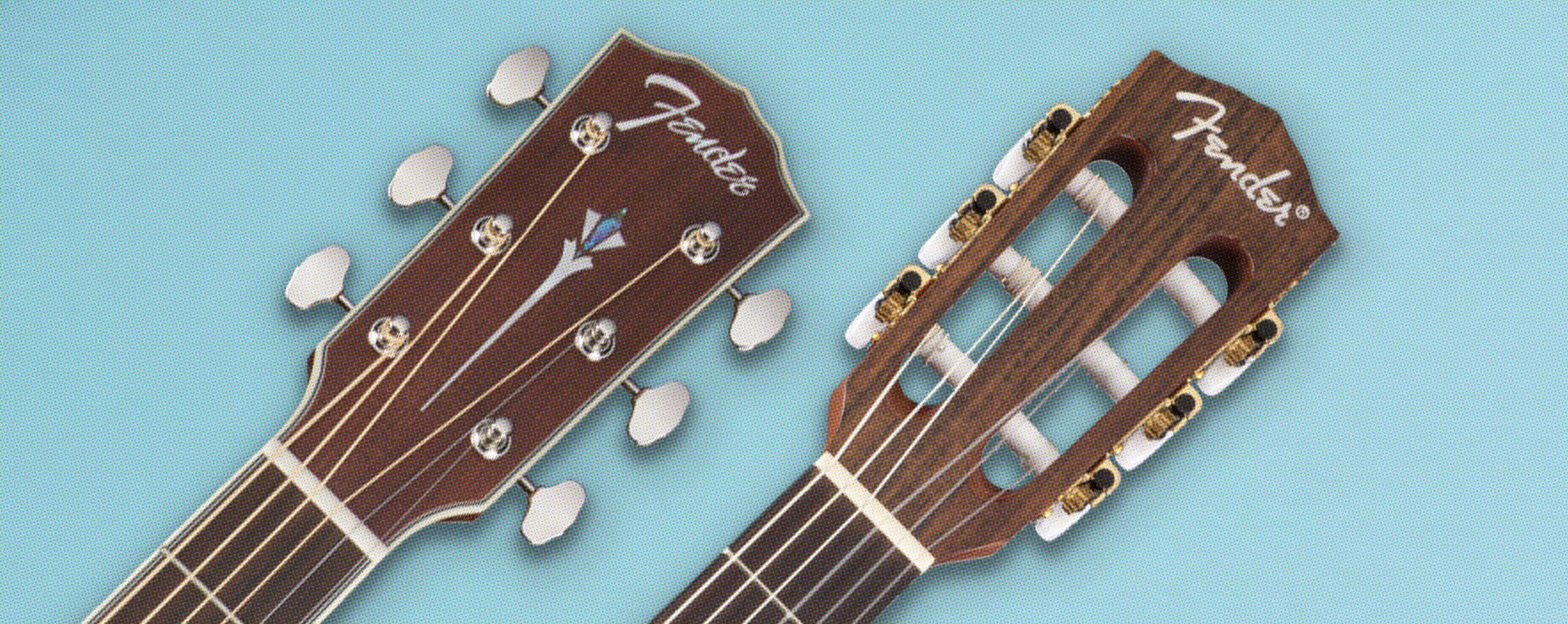
On the left, a steel-string guitar headstock. On the right, a classical guitar headstock.
In between acoustic and electric is a semi-acoustic (or acoustic-electric). These are acoustic guitars that can be plugged into an amp or played like a normal acoustic. They are the best and worst of both worlds. Being able to plug them in removes the need for a microphone.

Above is Patrick’s Martin 000CXE acoustic-electric.
Electric
Though solid body guitars are by far the most popular today, hollow body and semi-hollow body guitars also exist. We will focus on solid body guitars only.
All musical genres have specific guitar models associated with them but the two most popular models in general are the Les Paul and Stratocaster. They are the most copied style of guitar. Guitars modelled after them but not made by Gibson or Fender are referred to as a Les Paul type guitar or Stratocaster type guitar. Guitarists can recognise most popular models like Les Pauls, Stratocasters, Telecasters, flying Vs etc. and tend to refer to guitars by their model names.
Below is a picture of Patrick and Joe’s guitar cases some time pre-hiatus, and those same guitars on a rack someplace on the side of a stage.
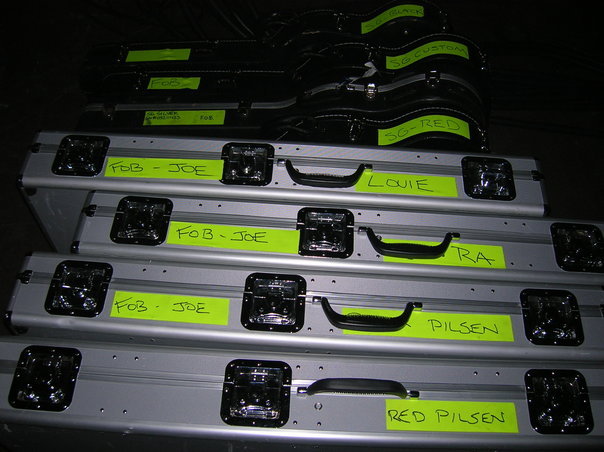
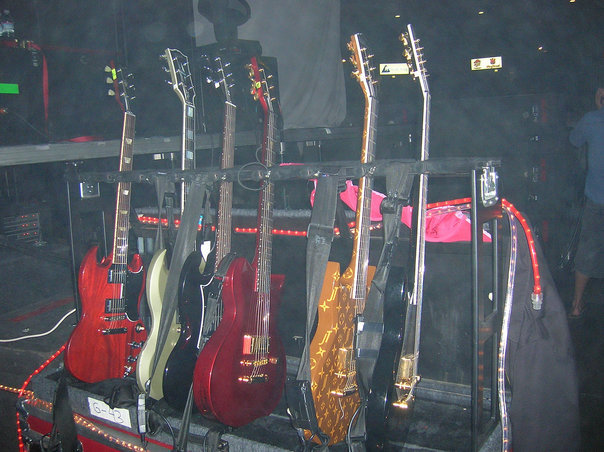
On the left are Patrick’s guitars and on the right are Joe’s.
When travelling with multiple guitars, labelling them is a smart idea since you won’t have to open the case to know which is which. Notice how they differentiate between the guitars with the model names as well as colors to differentiate further. Joe has two Washburn USA Pilsens, a red and a black one so labelling them both only as ‘Pilsen’ would still be confusing.
I see a distinct lack of model names in fic, which may be due to authors not knowing the model names to be fair. However, Patrick, Joe, Pete, and their guitar techs will know and use these model names.
Referring to a guitar by its brand is optional. It is quicker to say ‘SG’ than ‘Gibson SG’. However where there might be two guitars of the same model but made by different brands, brand names would be used to differentiate them. e.g. ‘Gibson SG’ vs ‘Epiphone SG’
Furthermore, you don’t have to play a specific genre with a specific guitar model. While having certain pickups will help achieve the wanted tone, plugins, pedals, preamps etc. can all help too. Play country with a flying-v if you want to, no one will stop you!
A guitar with a curved body and single cutaway. A Les Paul has two humbucker pickups and 4 knobs. Each pickup has its own volume and tone control. The jack is found on the side. Les Pauls and strats are good jack-of-all-trades guitars.

Patrick’s choice in guitar for most of the pre-hiatus era. The SG stands for ‘solid guitar’. They’re often used to achieve a harder rock sound. Based on the Gibson Les Paul but with two cutaways and a thinner body.
These guitars are famously prone to neck dive; when attached to a strap around the musician, the neck tends to fall to the floor rather than stay in place. From personal experience though, once you get used to it, you barely notice it. I wouldn’t recommend installing heavy tuning pegs on an SG though.
They usually have two pickups but Patrick’s SG custom below had three.

The stereotypical ‘rock’ guitar. Features three single coil pickups and a five way switch selector. Also called a ‘strat’ for short. It has one volume control and two tone controls. Most have a tremolo bridge, i.e. a tremolo bar can be installed.

Couldn't find a picture of anyone in FOB playing one.
Also called a ‘tele’ for short. Most have two single coil pickups and a single volume and tone control. Often used in rock and blues. Joe has a signature Squier tele.

The two main types of pickup are the single coil and the humbucker, the former being associated with Fender guitars and the latter with Gibson. Both work in similar but slightly different ways. Inside, there are magnets and a wire coiled around the metal bobbins, the tops of which are visible in most single-coils. When the strings vibrate, it disturbs the magnetic field and creates a current in the wires, known as electromagnetic induction (this is a very nerdy detail).
The difference between the two types is single-coils have, as the name suggests, one wire coil, whereas the humbucker has two running in opposite directions. Due to their different anatomy, the two pickups have different tones. Single-coils often sound clearer and pick up higher frequencies. Humbuckers were invented to get rid of the passive ‘hum’ sometimes output by single-coils when nothing is being played. They sound thicker and can be louder.
Guitars can have more than one different pickup types or multiple of the same. A HSS is a guitar with one humbucker and two singles (Humbucker - Single - Single). The humbucker is placed in the bridge position and the two coils in the middle and neck positions. Pickups can also be changed and it's one of the most common guitar DIYs.

Above, the anatomy of a single-coil.
Most pickups are passive but active pickups also exist. They require batteries to work to power the pre-amp built into the guitar. Since they contain less wire coils, they emit less ‘hum’ but output less sound overall, hence why a preamp is needed to boost the volume. They can also have better sustain. Active pickups are heavily associated with metal players and Fall Out Boy don’t use them.

A signature guitar refers to a guitar sold on the market that is either a replica of a musician’s guitar or designed with them. Artists sign contracts with guitar manufacturers and may be required to exclusively play with that company’s guitars onstage. Joe has a signature Squier telecaster and Patrick has his (now discontinued) Stump-O-Matic.
Picks
The word pick is short for plectrum but to casually call a pick a plectrum is a bit of a faux pas in the music world so I will only refer to them as picks.
There’s a surprising range of choices in picks. The most popular tend to be Dunlop Tortex picks but it’s another thing that depends on genre. Jazz IIIs are popular with a lot of metal shredders.
Often, bigger artists will have custom or branded pics with their logo on it. Brands get musicians to use their gear, artists get to design their picks, and they can throw the picks into the audience or sell them as merch, so it’s a win for both brands and musicians. They often make tour and album specific picks.
Picks vary in thickness and material. Like subway orders, most musicians pick a material and/or thickness and stick with it. They can also have textured patterns to help with grip but you can create your own grip by drilling holes into a pick or scoring a pick with a needle or other sharp object. However, most guitarists don’t bother with grips after a while of playing.
Some people use coins as picks as it produces a unique sound. Brian May famously used to use a sixpence and Jonny Greenwood used a coin on House Of Cards to produce that tremolo sound. However, this may damage strings and make them more likely to break and can leave a metallic residue on the strings. Plus, coins are stiff and not pointed so it can be hard to play accurately with them. FOB doesn’t use coin picks.
Guitarists playing in serious bands (i.e. playing in venues more than just a small room) will keep picks in a pick holder, especially if they’re singing too. Even at the best of times and when you’re not performing in front of people, sometimes you drop a pick and it disappears into the void forever. Keeping spare picks close by helps keep a tight show. Plus, then the remaining picks can be thrown into the crowd at the end of shows for fans to keep.
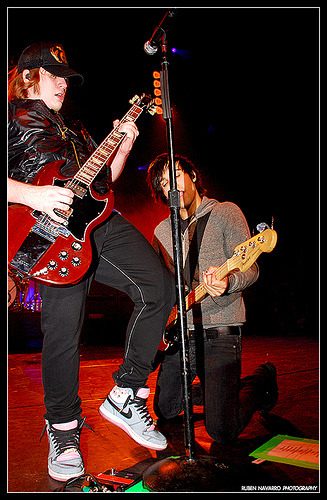

Patrick and Pete in 2007 with Dunlop .60mm tortex picks and FOB’s Infinity on High branded picks that were listed for sale on ebay.
Off stage, picks are similar to socks. Sometimes you put them down and they disappear never to be seen again until but every now and then, they turn up at the bottom of the washing machine after 6 months. Many musicians like to tuck their pick into their guitar strings by the nut for safekeeping to minimise the loss of picks to the shadow realm.
Dropping a pick into the sound hole on an acoustic guitar is also a common pain. You have to blindly shake the guitar upside until it comes out again. You could always leave it in there but it makes an awful rattly sound.
Fun fact I found out while researching for this chapter is that Patrick was still using Soul Punk pics during 2013 with Fall Out Boy. He switched to FOB branded ones at some point before or during 2014 but still an interesting, pretty useless fact.
Below is a picture of Patrick on 07/26/2013. The other picture is from 11/11/2011, while touring for Soul Punk. I couldn’t find any pictures of the picks close up but they have ‘patrick stump’ on one side and ‘SOUL PUNK’ on the other.

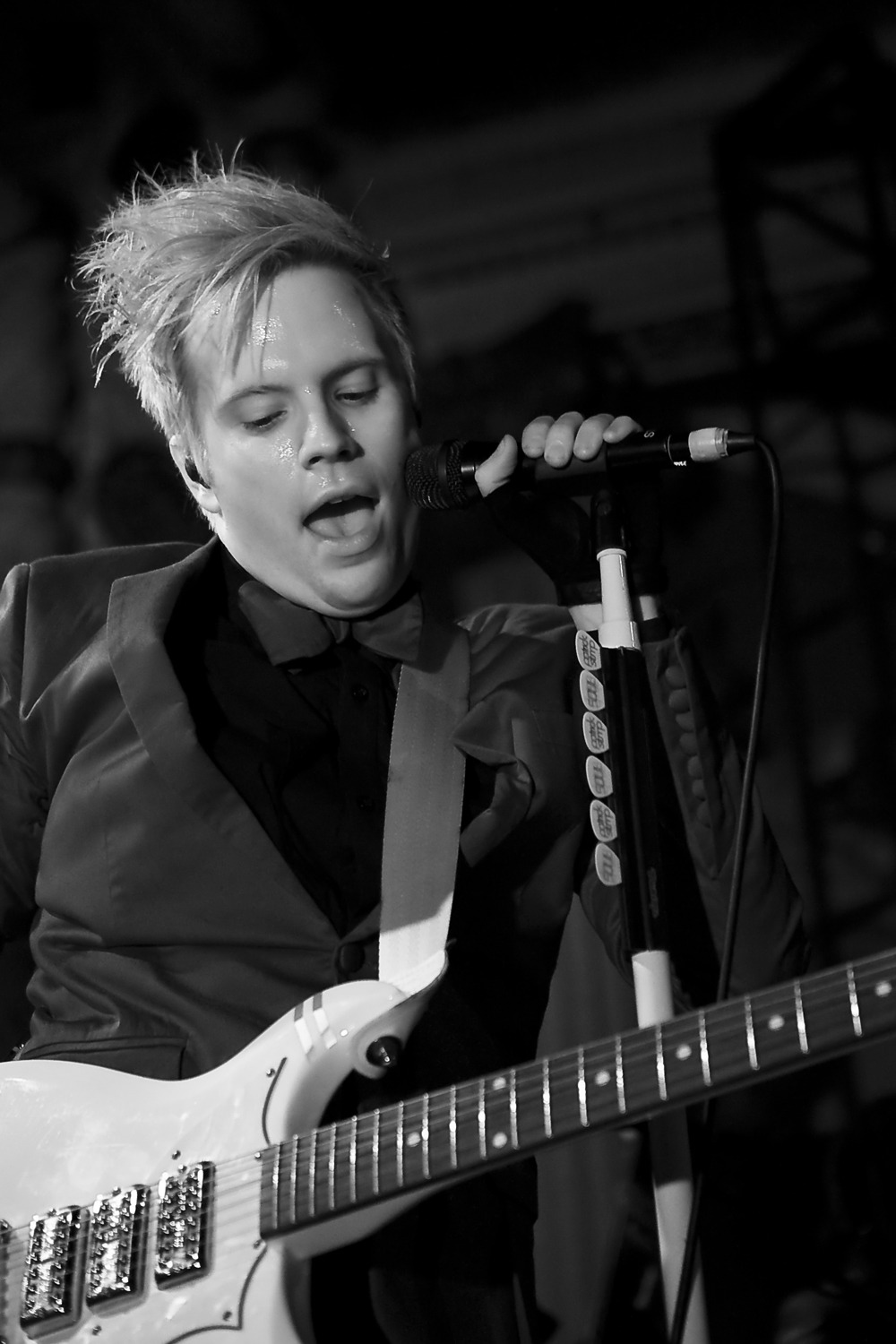
Straps
Most straps are adjustable. The meme of musicians with really low guitar straps being ‘rockers’ and guitarists with high guitar straps being really technical players is sort of true. A low guitar strap can be more comfortable when playing bar chords but makes it difficult to play solos and vice versa.
Every guitarist’s nightmare is the guitar strap coming loose on stage and their guitar crashing to the ground, creating such a discordant sound that the crowd boos your band off stage forever. Cheap straps made of thin material are particularly likely to slip off the pin. Straplocks exist to prevent such a thing from occurring. They go over the strap on the strap pin on both ends and secure the strap down. Hence why you’re unlikely to see a guitarist keep a strap on and just swap guitars live. That and it eats up more precious playing time to put a strap onto a guitar.
To protect cables from wear, guitarists loop their guitar cable through their strap. It takes tension off the connection between the wires and jack within the cable which is the place most liable to break. Plus, it can move the cable away from the guitarist’s feet so they are less likely to trip on their cable.
Capos
GIF for guitarists; There are two ways to pronounce this word. The correct way is kæpoʊ (ca-poh) and the incorrect way is keɪpoʊ (cay-poh). Only joking (mostly).
A capo presses down on the guitar strings, changing the key of the guitar. This means that the guitarist can play open chords further up the fretboard and avoid playing those same chords as bar chords. Capos are more commonly used when playing a song on an acoustic guitar, since the strings are thicker and bar chords are therefore more uncomfortable.
The very well known broke man’s capo is a device constructed of a pen and rubber bands or hair ties. I don’t recommend creating one yourself unless you are particularly desperate. It is difficult to get the pen to press down hard enough on the strings to avoid fret buzz. It’s extremely unlikely you will ever see one at a show.
Notes:
in terms of picks, I personally have textural issues with specific plastic materials so I stick with tortex (.60mm - .88mm). And I have extremely clammy hands but I prefer no grip. I think grips can be really useful for people still learning to use a pick though or who struggle with hand grip anyway.
but yeah thats a little detail you could add when writing autistic musicians; they probably care a lot more than the average musician about how the strings, guitar strap, guitar finish, and picks feel on their skin. a lot of textures involved in music...
if anyone knows of a picture of someone in FOB playing with a capo, please link
Chapter 4: Common Techniques
Notes:
Last edited 2025/07/12:
Added harmonics and whammy bars + edited tremolo picking section to include America’s Suitehearts
(See the end of the chapter for more notes.)
Chapter Text
All of these techniques are common so Patrick and Joe will know all of them, though I think Patrick likely wouldn’t have been confident in more ‘fancy’ ones such as harmonics or sweep picking in the very early days of the band since guitar wasn’t his main instrument. Again, that’s just speculation. FOB doesn’t use a lot of harmonics so it’s hard to tell and not very relevant.
Bends
Pushing or pulling a string to raise the pitch of the note. The guitarist knows how far to bend the note by ear. This is usually done with multiple fingers to mute other strings and provide more power behind the bend, making it sound clearer. Most commonly used in solos and in combination with vibrato.
Chord shapes
I won’t be explaining what each chord name, such as major, minor, diminished, means in this section. I recommend this webpage for a good explanation and David Bennet Piano for more detail. I will also only cover the chords commonly used throughout Fall Out Boy’s discography so as much as I adore major nine chords, I won’t discuss them here.
This website will tell you what a chord’s name is from the shape on a guitar.
Note: On a piano, the first finger is the thumb and the fifth finger is the pinkie finger. However, since guitarists don’t fret with the thumb (99.9% of the time), the first finger is the index finger and the ring finger is the fourth finger instead.
Power chords
The easiest chord shape by far and usually the first chord you learn to play on an electric guitar. A power chord is a fifth chord and consists of a root note, the fifth, and an optional octave. It is used in a lot of rock, metal, punk, and other genres of music. With a little distortion, they sound ‘powerful’ as the name suggests.
There are two ways to play the chords; the ‘classical’ way and the ‘rockstar’ way. Most musicians have a preference for one or the other. To play a classical way, the root note is played with the first finger, the fifth note is played with the third finger, and the octave is played with the fourth finger by tucking it under the third finger. When playing the rockstar way, instead of tucking the fourth finger under the third finger, the guitarist presses down with the third finger, fretting more than one string at a time. Guitarists may use a mix of both depending which one will make it easier to transition to the next chord.
Open chords
This refers to any chord that contains at least one open string, i.e. the string is played with none of the frets held down. A fretted string has a different tone to an open string so can sound recognisably distant. Usually also one of the first chord types you learn to play, especially on an acoustic. The most common open chords are E, A, F, G, C, D, and their minor counterparts, though other open chords exist too, naturally.
The ‘CAGED’ system is a way of learning the notes on the fretboard based on open chords that I won’t be detailing but it is popular. An alternative that is also used a lot is ‘three notes per string’ , also known as 3NPS.
Barre chords
This refers to any chord where a finger is used to ‘barre’ multiple strings, i.e. one finger holds down multiple strings, usually the index finger. When playing a guitar tuned to drop D, power chords can be played by barring the lowest three strings. In the verses of 27, Patrick plays barre chords and an Em open chord.
Hammer ons
When going to fret a note, the guitarist hits the note with their finger hard enough to cause the string to ring out without being plucked. Can be used to play faster. It is often used in solos, riffs, and with pull offs.
Harmonics
First, a little background about frequencies just so you can appreciate why harmonics work, especially if you don’t have a string instrument on hand to experiment with at home. This information isn’t necessary and the average guitarist will know how to hit a harmonic but not necessarily know the following: (I just find it interesting and helps make the techniques make sense)
When a note is played, we tend to hear it as one cohesive sound even though it’s actually formed of multiple frequencies. Without going too much into music theory and physics, the part that is loudest to our ears is the lowest frequency and called the ‘fundamental frequency’. On top of that, there are overtones which sound higher but usually quieter.
I’m going to use overtone singing as an example of this because I find it interesting. In the video, it sounds like the singer begins by singing one note and then adds more notes on top of that. They do this by amplifying (making louder) the harmonic overtones which are already there. Here’s another example of overtone singing.
A string harmonic is when the player isolates overtones using one of a few techniques, hence why harmonics sound higher in frequency than the note it's played on. There are four main techniques for playing harmonics on a guitar. When playing them on an electric guitar, playing with the bridge pickup turned on instead of the neck pickup and with added distortion will produce a clearer sound. The most commonly used harmonics are natural and pinch harmonics.
Natural harmonics
The easiest harmonic . You touch the string gently with a finger on the left hand without fretting the string (i.e. not pushing down on the string) in a certain spot and then pluck the string as normal. The best spots are just above or on top of the next fret on the 5th, 7th, and 12th frets, though there are other spots.
Pinch harmonics
A pinch harmonic is played by playing a note normally, either fretted or open, and in the same motion, hitting the string with a part of the hand or finger of the fretting hand. It can create a ‘squeal’ sound, especially with added distortion, hence why they are also called squeals.
Pinch harmonics will sound slightly different depending on where they are played on the string and you want to find the sweet spot that sounds good, of which there may be multiple. Each guitar will also sound and play slightly differently. It’s easier to play pinch harmonics on the lower string. This is my favorite video on how to play them as the youtuber shows why the technique works.
Bar chords are what beginner guitarists struggle with and hitting pinch harmonics consistently is often what intermediate guitarists struggle with. Hitting your first few pinch harmonics is a common lightbulb moment and is often an accident. It takes practice to be able to hit them consistently though.
Artificial harmonics
You fret a string with the left hand and place the right index finger on the string exactly 12 frets higher like with a natural harmonic. Then you use one of the other fingers on the right hand, usually the thumb, to pluck the string behind the index finger resting on the string. Video example .
Tapped / Touched harmonics
A similar technique to artificial harmonics but rather than plucking the string, you tap 12 frets higher than the fretted note. Video example.
Alternatively, you can rest the right hand on the 12th fret and tap the 5th and 7th frets with the left hand. The chorus of Buried Myself Alive by The Used is a great example.
Muting
Left hand, right hand, thumb muting
Accidentally hitting the wrong guitar string can sound jarring and they have a tendency to ring out when not being played regardless so muting is one of the most important techniques to master. There are three main techniques.
Left hand muting is most commonly used to mute the higher strings. The fingers of the fretting hand rest gently on the strings to be muted so that they don’t ring out. If plucked, it causes a percussive noise known as a dead note, denoted by an ‘X’ in tablature. Here are two bars of the rhythm guitar pulled from the intro of w.a.m.s.:

Right hand muting is generally used on the lower strings, though naturally there are times where you’d need to mute the higher strings with your right hand. Most people use the side of their palm but the side of the thumb and fingers on individual strings can be used too. For the solo on 27, I personally rest my right hand middle finger on the high E when not playing it. Right hand muting does not refer to palm muting, as that is a slightly different technique not intended to mute the strings entirely.
Thumb muting is another left hand technique where the guitarist twists their fretting hand so that their thumb can just rest on the low E string. It’s most commonly used for open chords like C where the low E string is not played.
Palm muting
The guitarist rests their palm by the guitar bridge, only just touching the strings so that the note still partially rings out. This is the technique that creates the ‘chugging’ sound heard in a lot of rock and metal. Often used in combination with power chords. Palm muting is denoted by ‘P.M.’ above or below the tabs followed by a line to show how long the guitarist should mute for. The verses in sixteen candles are largely palm muted.
Other muting techniques
A string dampener can be used to mute the strings not being played. It usually consists of some soft material that touches the strings and some way to wrap it around the guitar neck or headstock. In some guitars, the strings behind the nut ring out so a dampener can be placed behind the nut, or it can be placed after the nut to mute open strings. They are mostly used during recording to ensure the highest possible quality recording. A broke guitarist will use a clean (hopefully) sock tied around the guitar as it gets the same job done.
I have also seen musicians who are recording getting a technician to mute the open strings for them.
Picking
Strumming is hitting multiple guitar strings in a sweeping motion so that they ring out simultaneously (different to sweep picking). A single string is plucked or picked.
A down-stroke is when the guitarist strums or plucks away from their body, towards the floor. An up-stroke is when the guitarist does the opposite and picks up away from the floor and towards their body. The most commonly used picking techniques are down picking, alternate picking, and economy picking. They do sound slightly different and guitarists can hear the distinctions or figure out from the notes what type of picking a musician must be using. For example, the riff in I Don't Care sounds too smooth to be (comfortably) down-picked.
Exclusively playing downstrokes. This can give a heavier sound when downpicking very quickly. The ability to downpick well at high tempos is considered very impressive and takes a great amount of practice. James Hetfield of Metallica comes to mind for me as someone many guitarists look up to for his picking ability.
Alternating between up and down strokes. This makes it more efficient than downpicking, allowing the guitarist to play faster with less effort.
Like alternate picking, a mixture of up and down strokes. However, economy picking refers to the practice of picking with the smallest possible motion to reach even faster speeds. If the guitarist is going to play on a string above next, they pick upwards, and if they’re going to play on a string below next, they pick downwards. This relies heavily on muscle memory. Some refer to economy picking as alternate picking as well since economy picking is technically a form of alternate picking.
Tremolo picking refers to alternate picking the same note very quickly. Occasionally may be referred to as double picking.
It’s not a technique used often in FOB songs. The only one I can think of is America’s Suitehearts. You can hear tremolo picking by both the rhythm and lead guitar in the intro as well as in the bridge. It’s much more commonly used by MCR and Thursday like in the solo of Thank You for the Venom.
The word tremolo itself may refer to other things too such as vibrato, a tremolo bar, or a tremolo guitar pedal.
Mostly used by metal musicians and to play fast arpeggios across the strings using a smooth ‘sweeping’ motion up and down the strings. Often used with hammer ons and pull offs. Not used by FOB but as Joe is a metal fan, he likely plays songs with sweep-picking in them.
Pull offs
When fretting a string, the guitarist simultaneously lifts their finger from the fret and plucks the string with that finger so that it rings out the note below. This can be denoted either by a p between two notes, e.g. 5p3, or a legato symbol between two notes on the same string which the guitarist will know means to pull off.
Often used in solos, riffs, and with hammer ons. It can be used to play faster as picking is not required.
See 2:45 in I Slept With Someone In Fall Out Boy for an example of a riff composed with multiple pull offs.
Technically, not plucking the string with the fretting finger when pulling off is called a hammer off but they’re functionally useless, though some people will call all pull offs hammer offs. However, pull off is by far the most widely used term.
Slides
Holding down a fret and sliding up or down to another fret. In essence, a glissando. Slides are denoted by a line up to a note or down to a note. A guitarist can slide on more than one string at the same time, such as in the verse riff of This Ain’t a Scene. FOB and many other rock bands end songs with a slide out where the guitarist slides off into an open note like at the end of Fame < Infamy or West Coast Smoker. Plus, slides can often be used between chords to make the transition sound smoother.
Note: sliding is different to slide guitar, which is a blues technique for playing guitar where a hard object called a slide is used to create glissandos and vibrato. They’re not used by FOB but are used in the Breaking Bad theme song. I have seen everything from a vape to a beer bottle being used as a slide.
Vibrato
When the pitch of a note modulates in a rhythmic way around the note. This can be done by bending the string slightly either up or down and returning to the neutral position quickly. It can also be played by wiggling the fretting finger or a combination of the two. Vibrato is denoted by a wiggly line above the note in sheet music.
Whammy Bars
Also known as a tremolo bar, vibrola, or vibrato bar/arm as they’re used to play vibrato as the name suggests, though it’s most commonly referred to as a whammy bar (more informal) or a tremolo bar (slightly more formal). It’s a metal rod that’s inserted into the guitar bridge that when pulled, changes the tension on the strings and therefore also changing the pitch of the strings. In alternative music, tremolo bars are often used to play divebombs.
Notes:
chordle is a fantastic game if you want to practise some chords. its wordle but for triads.
I also think it's so fascinating that people play instruments with ‘accents’ almost. I was playing with another guitarist once and he was so bewildered that I preferred the classical way to play power chords. Both of us were self taught, only I believe guitar was his first instrument and I had played ukulele before guitar so had gotten used to tucking my fingers underneath. When Patrick says he thinks of writing from the point of view of drums, he’s really not wrong! I think it comes across in what he writes.
I lovee a good slide out at the end of a song, it makes it sound like it's falling apart, especially when it’s real nice and slow.

saccharine_dream on Chapter 4 Fri 10 Jan 2025 08:51PM UTC
Comment Actions
video_tape on Chapter 4 Fri 10 Jan 2025 10:00PM UTC
Comment Actions
carootspiderman on Chapter 4 Sun 13 Jul 2025 04:13PM UTC
Comment Actions
video_tape on Chapter 4 Mon 14 Jul 2025 09:35AM UTC
Comment Actions